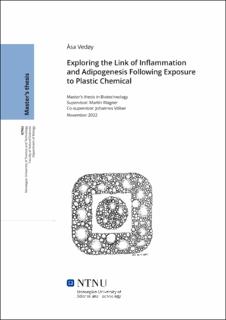| dc.contributor.advisor | Wagner, Martin | |
| dc.contributor.advisor | Völker, Johannes | |
| dc.contributor.author | Vedøy, Åsa | |
| dc.date.accessioned | 2023-01-11T18:19:39Z | |
| dc.date.available | 2023-01-11T18:19:39Z | |
| dc.date.issued | 2022 | |
| dc.identifier | no.ntnu:inspera:124662032:44115703 | |
| dc.identifier.uri | https://hdl.handle.net/11250/3042813 | |
| dc.description.abstract | Den aukande førekomsten av fedme er eit enormt helseproblem på befolkningsnivå. Ifølgje den obesogene hypotesa er feittvev utsett for eksponering av metabolismeforstyrrande kjemikalie, spesielt i tidleg alder. Kommersielle plastmateriale er bygd opp av ei organisk polymermatrise og er tilsett ulike kjemikaliar, nokre av desse er identifisert som fedme- og/eller metabolismeforstyrrande. Ein veit ikkje om kvardagsprodukt av plast inneheld metabolismeforstyrrande kjemikaliar. Me undersøk difor effekten av kjemikaliar frå kvardagsprodukt av plast i feittceller. For å stadfeste våre tidlegare funn, eksponerte me 3T3-L1 celler for kjemikaliar ekstrahert frå plastprodukt. For å vidare undersøkje om det var ein sensitiv fase for eksponering av feittceller, eksponerte me cellene for plastkjemikaliar i løpet av ein differensieringsanalyse, anten i differensieringsfasen, i vedlikehaldsfasen eller gjennom analysen. For å undersøkje om plastkjemikaliane utløyste ein betennelsesrespons i feittcellene kvantifiserte me interleukin (IL)-6 og tumornekrosefaktor-alfa (TNF-alfa) nivået frigjort av cellene etter eksponering av plastekstrakta. I den vidare undersøkinga av dei underliggjande mekanismane påverka av plastekstrakta, studerte me det endra genuttrykket i feittcellene.
Me fann ut at differensieringsfasen var eit sensitivt tidsvindauge for eksponering av plastkjemikaliane, saman med den positive kontrollen, rosiglitazone. IL-6 frigjeringa var høgare under differensieringa samanlikna med slutten av vedlikehaldsfasen og to av ekstrakta forårsaka ei høgare IL-6 frigjering samanlikna med dei resterande ekstrakta. I motsetjing til IL-6 vart ikkje TNF-alfa påvist. I den vidare undersøkinga av underliggjande mekanismar påverka av ekstrakteksponeringa observerte me at plastkjemikaliane forårsaka ei liknande endring av fleire gen, i tillegg til å vere ulike frå effekten av rosiglitazone. Resultata våre indikerer at eksponeringa av plastkjemikalar tidleg i livet kan medverka til fedmepandemien, medan linken mellom betennelsesresponsen og den kjemiske eksponeringa var ikkje tydleg. Dei underliggjande mekanismane som vert påverka av plastekstrakta inneber utilstrekkeleg oksygentilføring, endoplasmatisk retikulum (ER) stress og oksidativt stress i cellene, alt relatert til fenotypen til personar med fedme. | |
| dc.description.abstract | The expanding prevalence of obesity is an enormous health issue on a populational level. According to the obesogenic hypothesis adipose tissue is susceptible of exposure to metabolism disrupting chemicals (MDCs), especially during early life. Commercial plastic materials contain an organic polymer matrix and various chemicals, and some of the chemicals are known obesogens or MDCs. It remains however, to identify whether everyday plastic products contain MDCs. We therefore investigated the effects of adipocyte exposure to plastic chemicals extracted from everyday products. To validate our previous findings, we exposed 3T3-L1 to plastic extracts and to investigate whether there is a sensitive exposure window in the adipocyte differentiation, we exposed the cells to the plastic chemicals during the adipogenesis assay in three different windows of exposure. To investigate whether the plastic chemicals were triggering an inflammatory response in the adipocytes, we quantified the interleukin (IL)-6 and tumor necrosis factor alpha(TNF-alpha) release after chemical exposure. In the further investigation of the underlying mechanisms for the adipogenic induction, altered gene expression in the adipocytes caused by chemical exposure was studied.
We found that the differentiation phase was a further sensitive window of exposure for all the plastic extracts, along with the positive control, rosiglitazone. The IL-6 release by the adipocytes was higher during the differentiation compared to the end of the experiment, and two of the extracts caused a higher IL-6 release compared to the remaining extracts. In contrast to IL-6, TNF-alpha was not detected. In the investigation for underlying mechanisms of the induction of adipogenesis, we observed that the extracts caused a similar alteration of several genes, which was different to the effect of rosiglitazone. Our results suggests that plastic chemical exposure early in life could contribute to the obesity pandemic, the link between the inflammatory response and the chemical exposure was however not clear. The underlying mechanisms affected by the plastic extracts imply hypoxia, endoplasmic reticulum (ER) stress and oxidative stress in the cells, all related to the obesity phenotype. | |
| dc.language | eng | |
| dc.publisher | NTNU | |
| dc.title | Exploring the Link of Inflammation and Adipogenesis Following Exposure to Plastic Chemical | |
| dc.type | Master thesis | |
